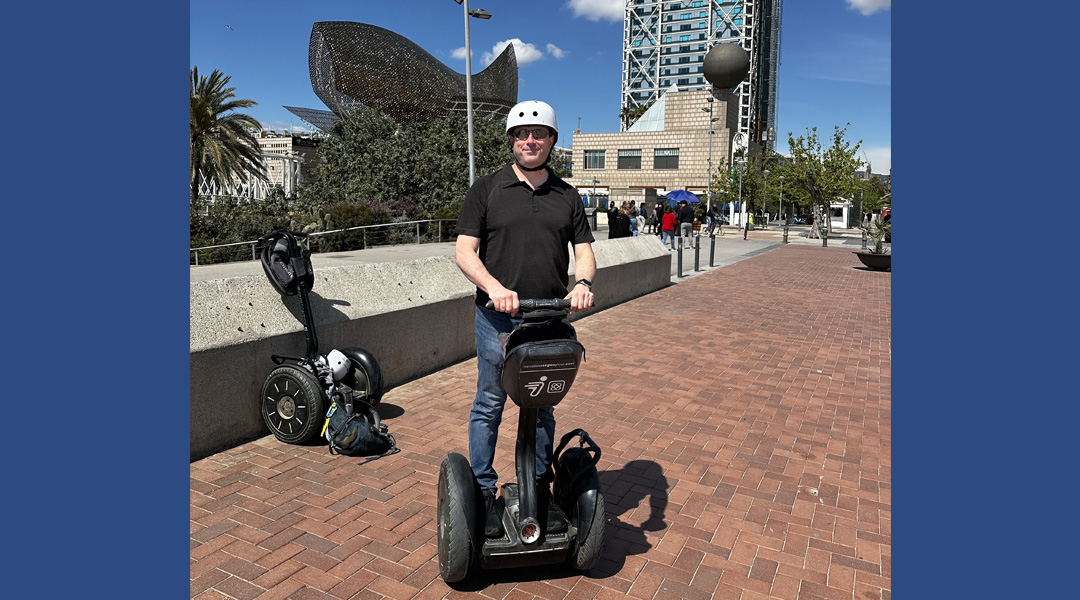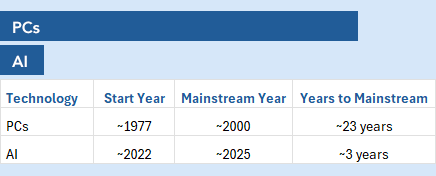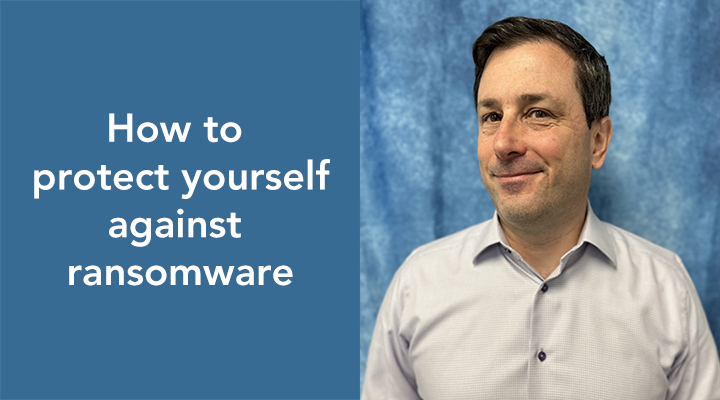There was a time when computers were merely “nice to have.” Novel. Fascinating. Something to fill a spare hour. And there were more of those spare hours because the world was not yet the pulsing, demanding, 24/7 machine that it is now, especially on the leading edge of an AI revolution.
But dialing back a few decades, I remember my folks reminiscing about the first home computer they bought back in the 1980s. They kept it in the corner of the den like it was a decoration, repeating witty observations like, “If I don’t turn it on, I can’t break it.” And when they did use it, they were continually swapping out floppy disks because that’s where documents and software lived — computers had very little memory in those days.
Fast-forward ten years, and you couldn’t run a business without one. Or many. The PC had moved from “nice to have” to “essential.” It changed how we worked, who we hired, and how fast we could grow. In almost no time, IBM Selectrics (the gold standard of typewriters) were disappearing from desktops and gathering dust in basements.
Now, we’re standing at the same kind of crossroads with AI. And if you think it’s “too early” or “not for my business,” you might be about to make the same mistake a lot of companies made in the 80s.
Let’s walk through these parallel revolutions together.
The wheel. The PC. AI. What do these three things have in common? People resisted them because they represented change. (As you can see from today’s photo, I’m a fan of the wheel.) But resistance to change is futile, as Star Trek’s Borg might say, because it’s inevitable.
The big picture: productivity and growth
When PCs hit the mainstream, US productivity started climbing fast.
It was 1995. Bill Clinton was in the White House, Greg Norman was the world’s top golfer, and millions of Americans were just starting to hear that chirpy dial-up sound as they connected to AOL for the first time. And that’s when labor productivity started to rise by about 1.5%-2% every year, partly thanks to all those new computers.
New industries popped up. Entire departments (think typing pools) disappeared. New careers in IT, software development, and networking were born.
And what about money? By 2000, the PC revolution had added about $3.5 trillion to global GDP.
Now, here comes AI. Experts like consulting firms PwC and McKinsey forecast that AI could add $15.7 trillion to the global economy by 2030. (FYI, that’s not a typo.) It’s four times the value PCs added, and it’s happening much faster.
But why am I talking about that here?
Early adopters: recipes, address books, and a big head start
If you talk to early adopters from the 80s, they’ll tell you that even though they couldn’t wait to get that first Mac or PC into their homes, they didn’t find much use for it beyond storing their address book or filing a few favorite recipes. After all, there wasn’t a lot of software out there at the time.
And you know what? That was fine; it was enough.
Because once they got comfortable with the basics (booting it up, saving a file, learning how to use a mouse), they were way ahead when groundbreaking software like Excel and PageMaker arrived. Suddenly, they weren’t starting from scratch.
About ten years after PCs first showed up in homes, just about everyone who had a home computer was using AOL to send and receive email – another revolution that couldn’t have started without the PC.
These early adopters had the confidence to explore new and evolving tools that ultimately revolutionized communications, finance, and just about every other industry you can imagine.
AI is following the same pattern
The lesson here is if you can learn how to use AI to draft a press release, compose healthy recipes for the week, or organize your team’s shift schedule today, you’ll be in a much better position tomorrow to:
- Use AI to develop two or three sophisticated marketing options and evaluate which is likely to perform better.
- Build a custom chatbot to answer FAQs on your website, saving your team time while helping visitors faster.
- Summarize long reports into bullet points you can use for decision-making or slides.
The first step doesn’t have to be perfect. It just has to be a step.
At this point, learning AI is a lot like learning to drive. When you first get a learner’s permit, you’re not driving cross-country or handling rush-hour traffic. You’re driving slowly around empty parking lots, figuring out how to use the brake and turn signals. Without that low-pressure practice time, the idea of merging onto a busy highway would be terrifying. The same principle applies to AI. If you start with easy, low-stakes uses now, you’ll be ready when bigger, more powerful tools come your way.
And to underscore my point, remember that early practice like this is normal and pays off in all kinds of places:
- Intro college courses: You take Chemistry 101 before you tackle Organic Chemistry 401.
- Language learning: You master “Where’s the bathroom?” before negotiating in another language.
- Cooking: You learn to boil water and scramble eggs before taking on coq au vin or chocolate cake from scratch.
It’s the same idea with AI: small steps today prepare you for bigger wins tomorrow.
Job creation and displacement: The good, the bad, and the new
With the PC boom, we lost a lot of jobs that used to be “good jobs.” Secretaries, typists, clerks, and even certain factory workers saw their roles shrink or vanish.
But we also gained millions of new jobs: not just in IT support, software development, and networking, but also in administrative support, customer service, bookkeeping, marketing, and office management. Anyone who learned to work faster and smarter with a computer became more valuable almost overnight, and businesses that helped their people adapt saw huge gains.
AI is following a similar playbook but speeding things up. Routine, repetitive tasks are already being automated in areas like basic customer service, document review in law firms, even some lower-level coding.
But new opportunities are rising just as fast: AI trainers, prompt engineers, AI ethicists, machine learning ops managers. McKinsey & Company believes that globally, AI could create as many as 20-50 million new jobs by 2030 to more than replace lost occupations. And they won’t all be AI engineers.
As AI shifts where we live and work, there will be more call for traffic engineers, urban planners, architects, and home energy consultants. Forecasts also note there will be more curriculum developers integrating AI into classrooms, and healthcare guides helping patients navigate new AI-assisted treatments. The ripple effects are huge, and they’re likely to change jobs in every industry.
Fears: then and now
Back in the 80s, the fear was “computers will replace people.” Newspapers ran headlines about mass unemployment.
Today, with AI, the fear sounds bigger: “AI will replace humanity.”
Some of that fear is healthy. We need guardrails. We need responsible development. But here’s the thing: every major technological leap, from seam engines to electricity to PCs, brought fear before it brought prosperity.
If history is any guide, businesses that lean in early, learn to use the new tools, and adapt are the ones that come out ahead.
The perks of being early
The companies that embraced PCs early built huge advantages. They were faster, more accurate, and better at scaling up.
Today, AI early adopters are already pulling ahead. They’re using AI to:
- Speed up research
- Personalize marketing
- Automate reporting
- Improve customer service
- Streamline hiring
And they’re freeing up their human teams to focus on the high-value, creative, relationship-driven work that machines can’t touch.
If you wait for AI to “settle down” before you engage, you’re going to be playing catch-up while your competitors drive ahead.
Change is coming faster than ever
Here’s the biggest difference: the timeline.
Look at how long it took PCs to go from “niche” to “everywhere” versus how fast AI is moving:
In short:
- PCs took two decades to become essential.
- AI is doing it in about three years.
If you’re thinking, “I’ll just wait and see,” you might be outpaced before you even get started.
What’s Next?
If you’re feeling overwhelmed, you’re not alone. The good news is you don’t have to become an AI expert overnight.
Start simple:
- Try an AI tool that speeds up something small (like email writing or scheduling).
- Identify one business process you could make faster or easier with AI.
- Stay curious. This is a moving train, and it’s better to jump on now than try to catch it later.
Just as with PCs, the businesses that lean into change thoughtfully (one step at a time) will be the ones sharing success stories five years from now.
Let’s make sure yours is one of them.
—–
P.S. Wondering where to start? Here’s a practical, low-stress path:
Start with these beginner-friendly tools:
- Grammarly (with AI writing help)
- ChatGPT (for drafting emails, blog posts, reports)
- Otter.ai (for AI-generated meeting notes and transcriptions)
Then graduate to these when you’re ready:
- Canva (with AI design assistance for marketing materials)
- Surfer SEO (AI to improve your website content)
- DepositPhotos AI (for generating licensed, original images)
The important thing is to start. Small wins now build the skills you’ll need for bigger victories tomorrow.





